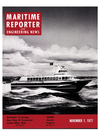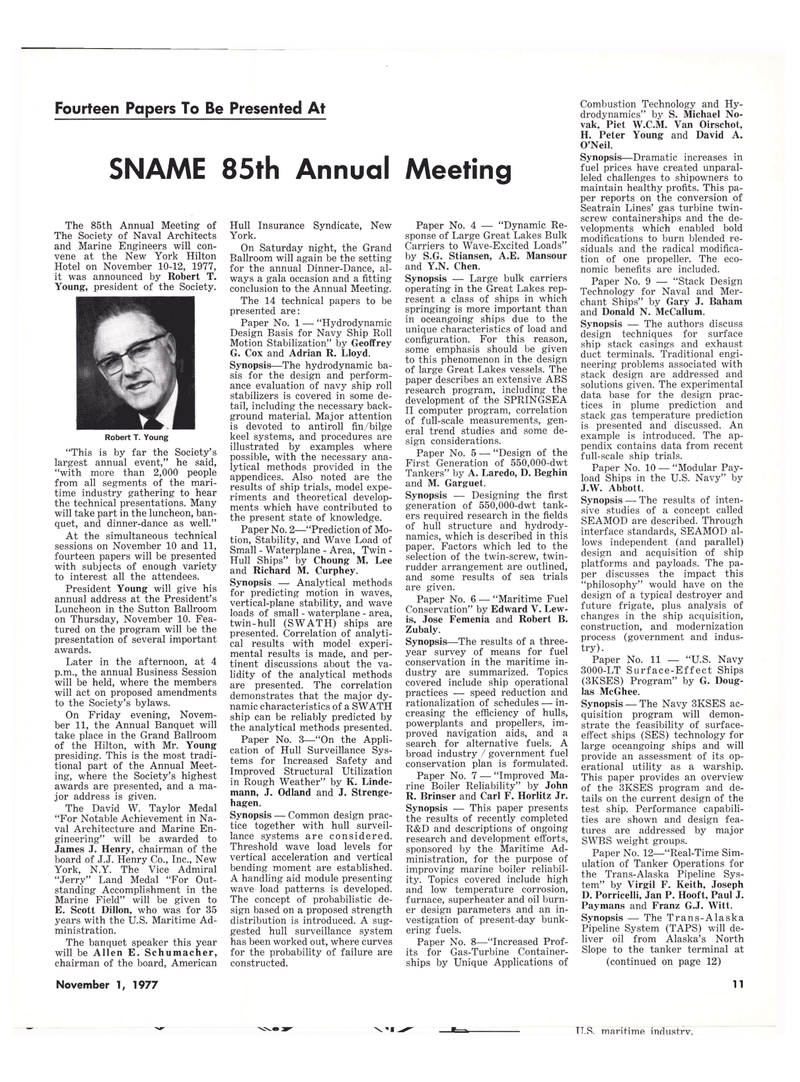
Page 9: of Maritime Reporter Magazine (November 1977)
Read this page in Pdf, Flash or Html5 edition of November 1977 Maritime Reporter Magazine
Fourteen Papers To Be Presented At
SNAME 85th Annual Meeting
The 85th Annual Meeting of
The Society of Naval Architects and Marine Engineers will con- vene at the New York Hilton
Hotel on November 10-12, 1977, it was announced by Robert T.
Young, president of the Society.
Robert T. Young "This is by far the Society's largest annual event," he said, "with more than 2,000 people from all segments of the mari- time industry gathering to hear the technical presentations. Many will take part in the luncheon, ban- quet, and dinner-dance as well."
At the simultaneous technical sessions on November 10 and 11, fourteen papers will be presented with subjects of enough variety to interest all the attendees.
President Young will give his annual address at the President's
Luncheon in the Sutton Ballroom on Thursday, November 10. Fea- tured on the program will be the presentation of several important awards.
Later in the afternoon, at 4 p.m., the annual Business Session will be held, where the members will act on proposed amendments to the Society's bylaws.
On Friday evening, Novem- ber 11, the Annual Banquet will take place in the Grand Ballroom of the Hilton, with Mr. Young presiding. This is the most tradi- tional part of the Annual Meet- ing, where the Society's highest awards are presented, and a ma- jor address is given.
The David W. Taylor Medal "For Notable Achievement in Na- val Architecture and Marine En- gineering" will be awarded to
James J. Henry, chairman of the board of J.J. Henry Co., Inc., New
York, N.Y. The Vice Admiral "Jerry" Land Medal "For Out- standing Accomplishment in the
Marine Field" will be given to
E. Scott Dillon, who was for 35 years with the U.S. Maritime Ad- ministration.
The banquet speaker this year will be Allen E. Schumacher, chairman of the board, American
November 1, 1977 11
Hull Insurance Syndicate, New
York.
On Saturday night, the Grand
Ballroom will again be the setting for the annual Dinner-Dance, al- ways a gala occasion and a fitting conclusion to the Annual Meeting.
The 14 technical papers to be presented are:
Paper No. 1 —• "Hydrodynamic
Design Basis for Navy Ship Roll
Motion Stabilization" by Geoffrey
G. Cox and Adrian R. Lloyd.
Synopsis—The hydrodynamic ba- sis for the design and perform- ance evaluation of navy ship roll stabilizers is covered in some de- tail, including the necessary back- ground material. Major attention is devoted to antiroll fin/bilge keel systems, and procedures are illustrated by examples where possible, with the necessary ana- lytical methods provided in the appendices. Also noted are the results of ship trials, model expe- riments and theoretical develop- ments which have contributed to the present state of knowledge.
Paper No. 2—"Prediction of Mo- tion, Stability, and Wave Load of
Small - Waterplane - Area, Twin -
Hull Ships" by Choung M. Lee and Richard M. Curphey.
Synopsis —• Analytical methods for predicting motion in waves, vertical-plane stability, and wave loads of small - waterplane - area, twin-hull (SWATH) ships are presented. Correlation of analyti- cal results with model experi- mental results is made, and per- tinent discussions about the va- lidity of the analytical methods are presented. The correlation demonstrates that the major dy- namic characteristics of a SWATH ship can be reliably predicted by the analytical methods presented.
Paper No. 3—"On the Appli- cation of Hull Surveillance Sys- tems for Increased Safety and
Improved Structural Utilization in Rough Weather" by K. Linde- mann, J. Odland and J. Strenge- hagen.
Synopsis — Common design prac- tice together with hull surveil- lance systems are considered.
Threshold wave load levels for vertical acceleration and vertical bending moment are established.
A handling aid module presenting wave load patterns is developed.
The concept of probabilistic de- sign based on a proposed strength distribution is introduced. A sug- gested hull surveillance system has been worked out, where curves for the probability of failure are constructed.
Paper No. 4 — "Dynamic Re- sponse of Large Great Lakes Bulk
Carriers to Wave-Excited Loads" by S.G. Stiansen, A.E. Mansour and Y.N. Chen.
Synopsis — Large bulk carriers operating in the Great Lakes rep- resent a class of ships in which springing is more important than in oceangoing ships due to the unique characteristics of load and configuration. For this reason, some emphasis should be given to this phenomenon in the design of large Great Lakes vessels. The paper describes an extensive ABS research program, including the development of the SPRINGSEA
II computer program, correlation of full-scale measurements, gen- eral trend studies and some de- sign considerations.
Paper No. 5 — "Design of the
First Generation of 550,000-dwt
Tankers" by A. Laredo, D. Beghin and M. Garguet.
Synopsis •—- Designing the first generation of 550,000-dwt tank- ers required research in the fields of hull structure and hydrody- namics, which is described in this paper. Factors which led to the selection of the twin-screw, twin- rudder arrangement are outlined, and some results of sea trials are given.
Paper No. 6 — "Maritime Fuel
Conservation" by Edward V. Lew- is, Jose Femenia and Robert B.
Zubaly.
Synopsis—The results of a three- year survey of means for fuel conservation in the maritime in- dustry are summarized. Topics covered include ship operational practices — speed reduction and rationalization of schedules — in- creasing the efficiency of hulls, powerplants and propellers, im- proved navigation aids, and a search for alternative fuels. A broad industry / government fuel conservation plan is formulated.
Paper No. 7 — "Improved Ma- rine Boiler Reliability" by John
R. Brinser and Carl F. Horlitz Jr.
Synopsis — This paper presents the results of recently completed
R&D and descriptions of ongoing research and development efforts, sponsored by the Maritime Ad- ministration, for the purpose of improving marine boiler reliabil- ity. Topics covered include high and low temperature corrosion, furnace, superheater and oil burn- er design parameters and an in- vestigation of present-day bunk- ering fuels.
Paper No. 8—"Increased Prof- its for Gas-Turbine Container- ships by Unique Applications of
Combustion Technology and Hy- drodynamics" by S. Michael No- vak, Piet W.C.M. Van Oirschot,
H. Peter Young and David A.
O'Neil.
Synopsis—Dramatic increases in fuel prices have created unparal- leled challenges to shipowners to maintain healthy profits. This pa- per reports on the conversion of
Seatrain Lines' gas turbine twin- screw containerships and the de- velopments which enabled bold modifications to burn blended re- siduals and the radical modifica- tion of one propeller. The eco- nomic benefits are included.
Paper No. 9 — "Stack Design
Technology for Naval and Mer- chant Ships" by Gary J. Baham and Donald N. McCallum.
Synopsis — The authors discuss design techniques for surface ship stack casings and exhaust duct terminals. Traditional engi- neering problems associated with stack design are addressed and solutions given. The experimental data base for the design prac- tices in plume prediction and stack gas temperature prediction is presented and discussed. An example is introduced. The ap- pendix contains data from recent full-scale ship trials.
Paper No. 10 — "Modular Pay- load Ships in the U.S. Navy" by
J.W. Abbott.
Synopsis -— The results of inten- sive studies of a concept called
SEAMOD are described. Through interface standards, SEAMOD al- lows independent (and parallel) design and acquisition of ship platforms and payloads. The pa- per discusses the impact this "philosophy" would have on the design of a typical destroyer and future frigate, plus analysis of changes in the ship acquisition, construction, and modernization process (government and indus- try).
Paper No. 11 — "U.S. Navy 3000-LT Surface-Effect Ships (3KSES) Program" by G. Doug- las McGhee.
Synopsis — The Navy 3KSES ac- quisition program will demon- strate the feasibility of surface- effect ships (SES) technology for large oceangoing ships and will provide an assessment of its op- erational utility as a warship.
This paper provides an overview of the 3KSES program and de- tails on the current design of the test ship. Performance capabili- ties are shown and design fea- tures are addressed by major
SWBS weight groups.
Paper No. 12—"Real-Time Sim- ulation of Tanker Operations for the Trans-Alaska Pipeline Sys- tem" by Virgil F. Keith, Joseph
D. Porricelli, Jan P. Hooft, Paul J.
Paymans and Franz G.J. Witt.
Synopsis — The Trans-Alaska
Pipeline System (TAPS) will de- liver oil from Alaska's North
Slope to the tanker terminal at (continued on page 12) 11
TT.S. maritime industrv.

 8
8

 10
10
